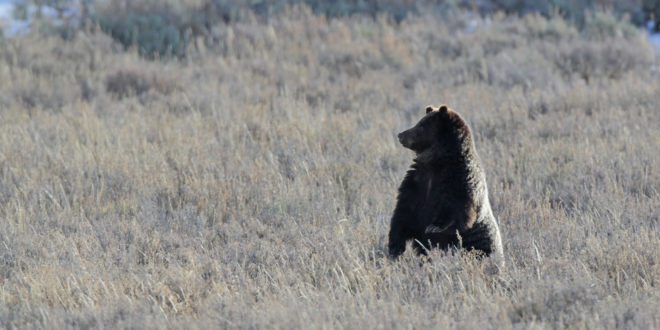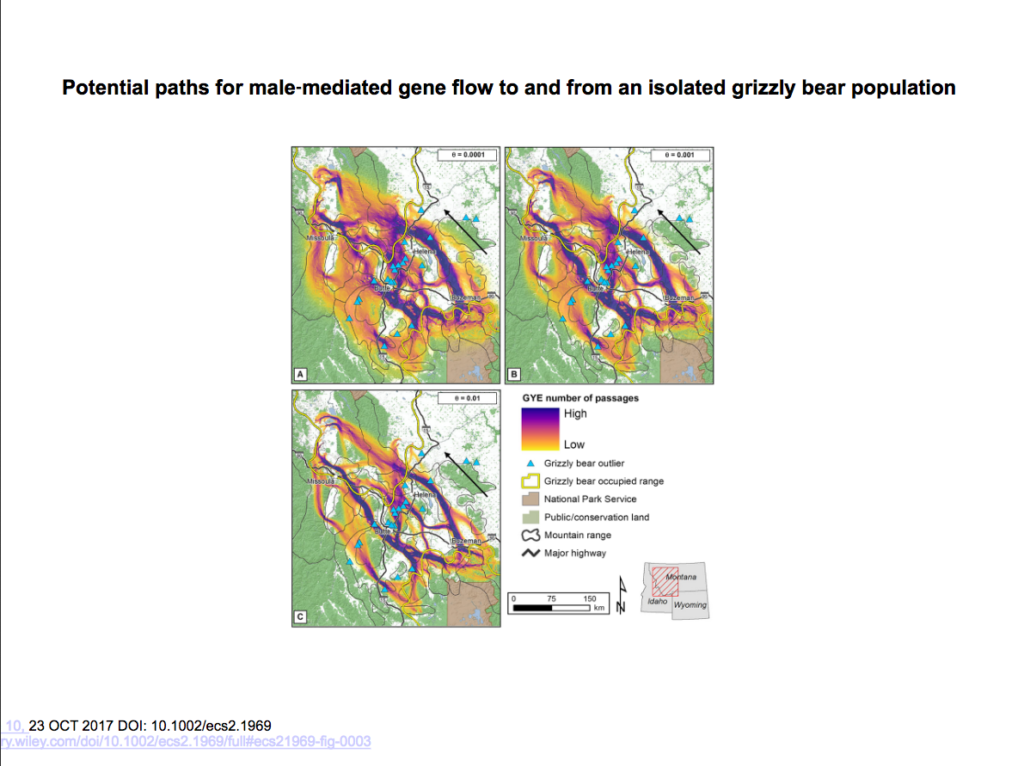Researchers continue to map the ways Yellowstone grizzly bears could reconnect with the population living around Glacier National Park.
Indeed, according to Interagency Grizzly Bear Study Team leader Frank van Manen, the bears are closer to reuniting that ever before.
The Bozeman Daily Chronicle reports van Manen spoke with the Yellowstone Grizzly Coordinating Committee, which oversees management of Yellowstone-area grizzly bears and includes federal, state and tribal representatives. At the same meeting, van Manen talked about the stability of Yellowstone’s grizzly population.
Van Manen is a co-author of a new study, published in the open access journal Ecosphere, about the potential for “male-mediated gene flow” between the Greater Yellowstone Ecosystem and the Northern Continental Divide Ecosystem. We previously reported on this study prior to its publication.
The study focuses on how male grizzlies (the most prone to roaming) could establish corridors between the two ecosystems, which could lead to grizzlies moving between ecosystems, pushing new genes into each. Both researchers and grizzly advocates seek this goal, seeing it as essential to the bear’s longevity. From the Chronicle:
Genetic data presented by van Manen showed that the Yellowstone population has distinct genes from those of other continental grizzly populations. The two populations have been isolated from one another for a long time, but it’s unclear how long.
“It could be, for all we know, as long as 100 years,” he said. “We really don’t know that.”
Van Manen said the Yellowstone population would certainly benefit from intermingling with the Northern Continental Divide bears, which would increase its genetic diversity, but he argues that the Yellowstone population isn’t going to blink out if connection doesn’t happen soon.
“There’s no indication that it’s at a level that would raise any concern about the population,” he said.
But bear managers agree that connecting the two is a long-term goal. The IGBST’s study analyzed GPS data from 124 male grizzly bears between 2000 and 2015 and tried to figure out the most logical pathways between the two populations, referred to in the study as “randomized shortest paths.” Maps included in the study color-code the paths for potential density.
You can see the maps below, courtesy of the Chronicle.
Several Montana officials spoke to the Chronicle about preparations their agencies are making for potential grizzly movements. Ken McDonald, wildlife division administrator for Montana, Fish, Wildlife and Parks, said van Manen’s data could be used to make sure people are prepared for bears. Mike Volesky, chief of operations at FWP, told the Chronicle they are working with the Department of Transportation to look at “pinch points” along the highway where bears would want to cross.
Bonnie Rice of the Sierra Club, which is suing the U.S. Fish and Wildlife Service over its decision to delist Yellowstone grizzly bears from the Endangered Species List, said the committee should look at ensuring hunter-bear conflicts are reduced. “Regardless of whether bears are listed or delisted, everyone wants to prevent conflicts,” Rice told the Chronicle.
 Yellowstone Insider Your Complete Guide to America's First National Park
Yellowstone Insider Your Complete Guide to America's First National Park







You must be logged in to post a comment.